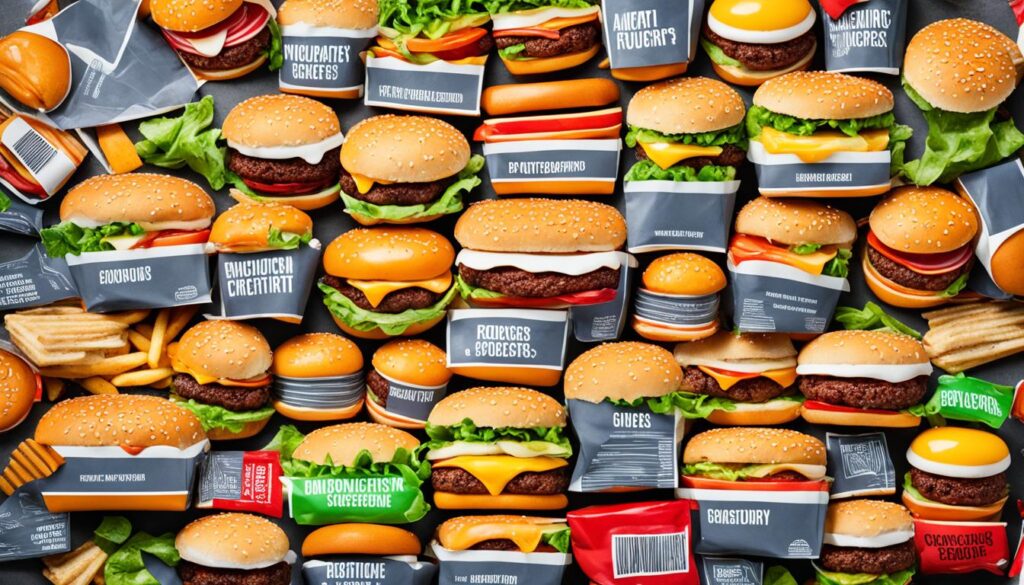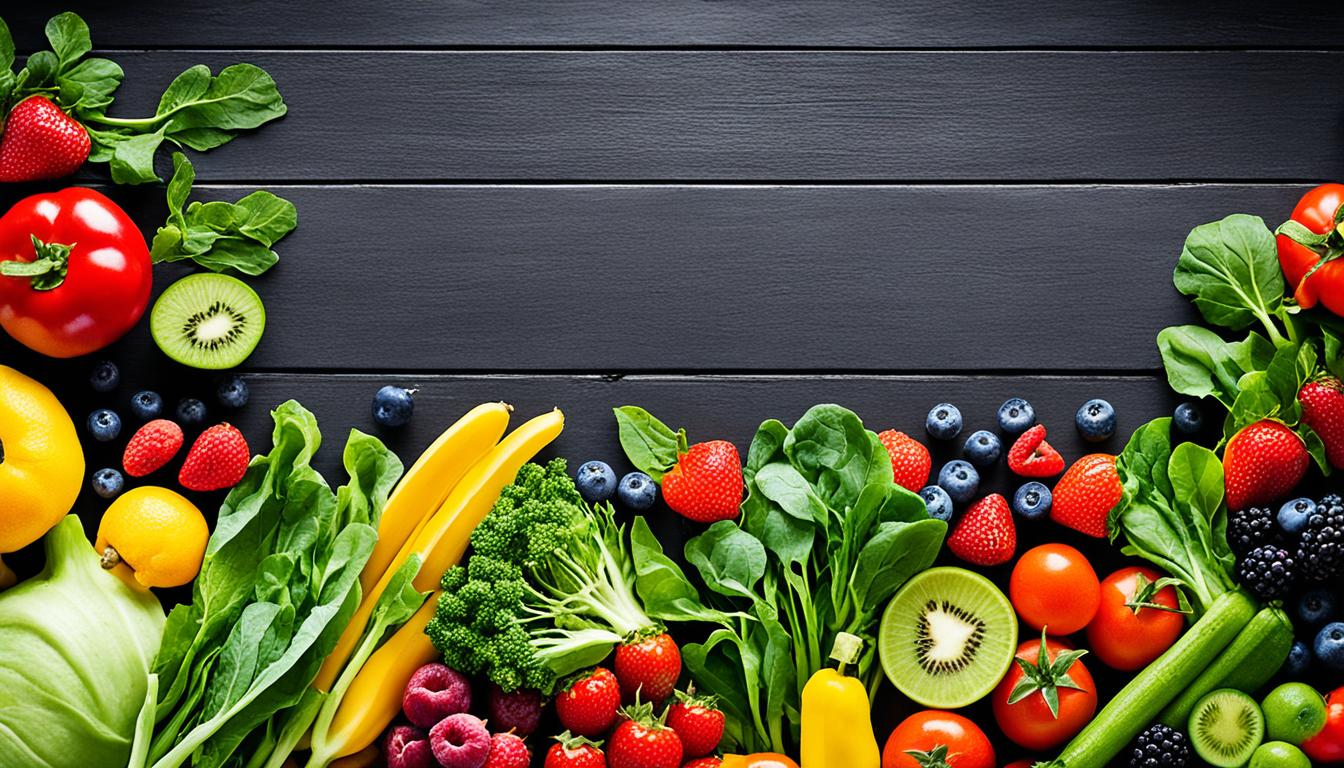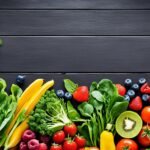Filling your plate with nutrient-dense whole foods can make you feel great. This is at the heart of clean eating, a way of thinking about nutrition. It’s become quite popular lately. Many wonder if clean eating is here to stay or just a trend. Let’s explore its benefits for our bodies and the Earth.
Clean eating means choosing foods that are as close to nature as possible. Think about fruits, veggies, whole grains, lean meats, and good fats. And it means saying no to processed, sugary, fatty, and salty snacks.1 By eating this way, we get more nutrients like fiber. But we cut out the not-so-good stuff. The idea is simple: eat real, whole foods to feel your best.
Key Takeaways
- Clean eating emphasizes nutrient-dense, whole foods over processed options.
- A clean eating lifestyle can provide health benefits like improved weight management and reduced chronic disease risk.
- Clean eating supports environmental sustainability through reduced reliance on resource-intensive foods.
- Carefully reading labels and minimizing added sugars and sodium are key principles of clean eating.
- Clean eating can be a delicious and satisfying way to fuel your body and the planet.
What is Clean Eating?
Clean eating means choosing foods in their natural form, without much processing.2 It’s about eating whole foods like fruits, veggies, grains, proteins, and good fats. In clean eating, you stay away from heavily processed snacks and packaged foods.2,3
Defining Clean Eating
Eating clean is the opposite of eating lots of processed foods. These processed foods add things like sugars, sodium, and artificial stuff.2,4
These foods usually lose their natural nutrients and fiber through processing. Clean eating means choosing less processed options.2,4
Clean Eating vs. Processed Foods
A clean eating lifestyle has many health benefits. It can help keep your weight in check and lower your chances of heart disease and diabetes.2,4
It’s because foods like whole grains and colorful fruits and vegetables are anti-inflammatory. They boost your health in many ways.2,4
The Benefits of Clean Eating
Clean eating focuses on whole, nutrient-rich foods that are good for you. It’s different from diets heavy in processed foods.2,4
By eating nutrient-packed whole foods, clean eating helps with weight, cuts the risk of diseases, and supports a healthy gut.2,4
The Principles of Clean Eating
Clean eating focuses on whole, natural foods rich in nutrients. This means a diet heavy on fruits, veggies, grains, and lean proteins. These foods are packed with fiber, vitamins, and antioxidants. They work together to keep our bodies healthy and strong.5 Eating this way means choosing fresh, unprocessed options over those that are heavily refined.5
Prioritizing Whole, Nutrient-Rich Foods
A main rule is to cut down on highly processed foods. Think white bread, pastries, and sugary drinks. These don’t offer much in the way of the good stuff our bodies need.5 Such foods are often stripped of important nutrients during processing. Clean eating stands for picking foods that are closer to their natural form.5
Minimizing Processed and Refined Foods
It’s also key to stay away from artificial additives and preservatives. These chemicals are in many processed foods to make them last longer or taste better. But they don’t do much for our health.526 Eating clean means going for foods that are pure and free from these harmful extras. Looking at labels can help us avoid them. This keeps our diet safe and natural.
Avoiding Artificial Additives and Preservatives
By choosing whole, nutrient-rich foods over processed ones, clean eaters do a lot of good for their bodies. They stay clear of artificial stuff too. This way, they stay true to the clean eating lifestyle.
Clean Eating and Fruits and Vegetables
Fruits and vegetables are key to a clean eating style. They are full of vitamins, minerals, and antioxidants.2 But, most Americans don’t eat enough of them. Adding more to your meals can boost your health. It lowers the chances of getting sick with things like high blood pressure and diabetes.2 These foods also help your digestion and can keep your weight in check.7
The Importance of Fruits and Vegetables
Studies show eating lots of fruits and veggies cuts your risk of cancer and heart problems.7 So, it’s good to eat more of them, even if they’re not organic.7
Choosing Organic Produce
For a clean eating plan, pick organic fruits and vegetables when you can. Organic methods don’t use harmful chemicals, which is better for the planet and people.2 Focus on organics for the “Dirty Dozen” to reduce chemical exposure.2 Also, choosing organic is a way to support the planet. It follows clean eating’s care for the environment.2
Whole Grains and Clean Eating
Whole grains play a big part in eating clean. They are full of complex carbs, fiber, and many vitamins.3 Unlike refined grains, whole grains keep their bran and germ. This keeps their fiber high and helps energy release slowly. So, you stay full and your blood sugar stays steady. Foods such as quinoa, brown rice, and oats are great for clean eating plans.
The Benefits of Whole Grains
Eating whole grains is key to clean eating and is very healthy. They have carbs that break down slowly, avoiding sugar spikes. The fiber in them helps with your digestion and keeps you full. Adding different whole grains to your diet helps you get all the nutrients you need.
Identifying Whole Grains on Labels
Buying whole grains for clean eating means checking labels carefully. Look for a whole grain stamp or check if the first ingredient is a whole grain, like whole wheat.3 Stay away from products with refined grains as the main ingredient. This processing removes key nutrients. Choosing real whole grains is how you stick to your clean eating goals.
Clean Eating and Protein Sources
Clean eating focuses on getting lean protein from natural, unprocessed sources. This includes things like poultry, fish, and eggs. Also, they use plant-based proteins such as beans, nuts, and seeds.3 These choices are low in bad fats and cholesterol, unlike some highly processed meats. By picking lean meats and plant proteins, you can keep your diet clean and healthy.3
Grass-Fed and Wild-Caught Choices
For better health, clean eating suggests looking for grass-fed, pasture-raised meats and wild-caught seafood. They are seen as better because the animals live more naturally, without antibiotics or hormones. Grass-fed beef and wild-caught fish are also richer in omega-3s. This can be good for your body and for the planet.38
Clean Eating and Processed Foods

Clean eating is about choosing whole, less processed foods. Yet, some processed foods can still be part of a clean eating plan. It’s all about checking the labels. Look for items with simple, natural ingredients and few additives. Stay away from products full of strange, manufactured chemicals. By checking labels, you can pick out the cleaner processed foods.
Reading Ingredient Lists
Highly processed foods often have harmful chemicals. These include synthetic preservatives, colorings, and flavorings.7 They have been linked to bad health effects. Clean eating means trying to avoid these chemical additives. The goal is to eat as few processed foods as possible. This way, you lower the risk of eating harmful additives.7
Limiting Exposure to Harmful Chemicals
For clean eaters, reading the labels on processed foods is key. Choose items with simple, natural ingredients and few additives. Stay away from products full of strange, manufactured chemicals. This is important for sticking to the clean eating principles.3 Checking labels helps you find the processed foods that are best. It’s how you keep away from harmful chemicals and additives.7
Reducing Added Sugars for Clean Eating
Limiting added sugars is key in clean eating. Americans eat more than they should. This leads to obesity, diabetes, and other health problems.5 Clean eating means avoiding processed foods and sugary drinks. Focus on the natural sugars in fruits and dairy. By cutting back on added sugars, you keep your diet healthy and clean.
The Dangers of Excessive Added Sugars
The average American takes in 55–92 grams of added sugar every day. This equals 13–22 teaspoons of sugar, making up 12–16% of total calories.9 Experts say we should aim for less than 10% of our calories from added sugars –9 for the best health. They actually recommend staying under 5% for an even healthier life.9 Overdoing it with added sugars can lead to being overweight, diabetes, and more health issues.
Identifying Added Sugars on Labels
Knowing how to spot added sugars on labels is crucial for clean eating. Added sugars can hide under many names, like sucrose or honey.10 To be sure, choose products with fewer or no added sugars. Learning these terms helps you stay true to clean eating.
Clean Eating and Sodium Intake
Clean eating means watching your sodium intake. Many Americans eat more salt than they should.11 The American Heart Association says we should have no more than 2,300 mg a day.11 They actually advise aiming for less, ideally under 1,500 mg.11 Too much salt can lead to high blood pressure. This, in turn, can up your chances of heart disease and stroke.11
To cut back on salt, clean eaters avoid processed food. These foods are often loaded with sodium.3 Instead, they use herbs, spices, and other tasty ingredients. This helps them use less salt while keeping their hearts healthy.
Using Herbs and Spices for Flavor
In clean eating, herbs and spices do a lot of the heavy lifting for flavor. They help dishes taste good without adding too much salt.3 Clean eaters love ingredients such as garlic, ginger, basil, and oregano. They also enjoy a little kick from chili powder. By using these, they need less salt and avoid processed seasonings. This way of eating is all about fresh, healthy ingredients. It makes meals both good for you and delicious.
The Environmental Impact of Clean Eating

Clean eating is good for more than just you. It helps the planet, too. Foods that are highly processed and full of meat make a big carbon footprint. They are not eco-friendly.12
On the other hand, meals focused on fruits, veggies, whole grains, and plant proteins are better for the earth. They don’t rely heavily on animals. So, clean eaters reduce their impact on the environment. Also, going for organic foods that are grown nearby reduces the footprint even more. This is because it cuts down on the travel and harmful farming methods.12
Reducing Your Carbon Footprint
The clean eating way supports farming that’s better for the planet. Eating food that’s organic and comes from the area means you are helping. It’s because such meals support farming that is kinder to the earth.
This sort of farming uses fewer harsh chemicals, keeps soil healthy, and lowers pollution. So, by choosing these foods, clean eaters help the planet. They support a food system that does not harm the earth.
Supporting Sustainable Agriculture
Focusing on plant foods and choosing organic and local options can do a lot of good. It reduces your carbon footprint and helps the environment.12
This way of eating is not just healthy; it is also good for the world we live in. It plays a part in keeping our food system and our planet going strong.12
Conclusion
Clean eating is a mindful way to feed yourself and the world. It focuses on eating unprocessed whole foods like fruits, veggies, whole grains, lean meats, and good fats. At the same time, you cut back on processed foods, sugars, and a lot of salt. Eating this way brings many health wins. You can manage your weight better, lower the risk of getting certain health problems, and help your stomach stay healthy.13
This way of life is also good for the Earth. By choosing foods that use fewer resources and supporting farming that cares for the planet, you do your part. It might take a little effort, but following a clean eating approach is both fulfilling for you and helpful for our world.13
But it’s important not to go too far. Being too obsessed with eating only what’s seen as “clean” can have its own dangers, like orthorexia nervosa. Staying balanced by enjoying a full life, with strong bonds, self-betterment, and growth, is key for staying healthy all around.13
FAQ
What is clean eating?
Clean eating is all about choosing whole, nutrient-packed foods. This includes fruits, veggies, whole grains, lean meats, and healthy fats. It means saying no to processed, high-sodium foods.
How does clean eating differ from a diet high in processed foods?
Clean eating involves choosing foods in their natural state. These options are rich in nutrients and fiber. In contrast, diets high in processed foods offer little but added sugar and salt.
What are the health benefits of clean eating?
Clean eating can help control weight and lower the risk of diseases. It supports gut health by providing nutrients, fiber, and antioxidants.
What are the key principles of clean eating?
The main principles are eating whole, minimally processed foods. This reduces the intake of refined foods. Also, it means not consuming artificial additives.
Why are fruits and vegetables important in a clean eating lifestyle?
Fruits and vegetables are essential in clean eating. They are full of vitamins, minerals, fiber, and antioxidants. This boosts health and helps prevent diseases.
How can choosing organic produce benefit a clean eating approach?
Organic produce reduces the exposure to harmful chemicals. It supports clean eating’s care for the environment and personal health.
What role do whole grains play in clean eating?
Whole grains are key for clean eating. They offer complex carbs, fiber, and many nutrients. This is unlike refined grains, which lack these benefits.
How can you identify whole grain options when shopping?
Look for the whole grain stamp or check the ingredients. If the first is a whole grain, like whole wheat, brown rice, or oats, it’s in line with clean eating.
What types of protein sources are preferred in a clean eating lifestyle?
Lean proteins are the focus, including poultry, fish, eggs, legumes, nuts, and seeds. It’s important to avoid high-fat, processed meats.
How can choosing grass-fed and wild-caught proteins benefit clean eating?
Grass-fed meats and wild-caught seafood are cleaner options. They are raised in more natural, hormone-free settings, aligning with clean eating values.
Can any processed foods fit into a clean eating lifestyle?
Some minimally processed foods with natural ingredients can be part of clean eating. The key is to choose items with few additives.
Why is limiting exposure to harmful chemicals and additives important in clean eating?
Clean eating avoids synthetic substances that are bad for health. The goal is to eat whole, natural foods to reduce the risks of these chemicals.
How can you reduce added sugar intake as part of a clean eating lifestyle?
Avoid foods with lots of added sugar by checking labels. Ingredients like sucrose and high fructose corn syrup should make you cautious. This is critical for a clean diet.
Why is limiting sodium intake important in clean eating?
Too much sodium raises health risks like high blood pressure. Clean eating means steering clear of processed foods that are high in salt.
How can using herbs and spices enhance flavor in a clean eating lifestyle?
Herbs and spices are great for flavor without the need for extra salt. They make food taste amazing while keeping it clean and healthy.
How does clean eating benefit the environment?
By focusing on plant-based, sustainable foods, clean eating also helps the Earth. It reduces our carbon footprint, promoting farming that’s good for the planet.
Source Links
- https://www.eatingwell.com/article/7882092/clean-eating-meal-plan-for-beginners/
- https://www.hsph.harvard.edu/nutritionsource/clean-eating/
- https://www.eatingwell.com/article/282469/clean-eating-foods-list/
- https://www.mayoclinichealthsystem.org/hometown-health/speaking-of-health/clean-eating-what-does-that-mean
- https://www.eatingwell.com/article/78846/7-tips-for-clean-eating/
- https://www.webmd.com/diet/a-z/eat-clean-diet
- https://www.healthline.com/nutrition/11-ways-to-eat-clean
- https://www.healthline.com/nutrition/lean-protein-foods
- https://www.healthline.com/nutrition/14-ways-to-eat-less-sugar
- https://www.heartandstroke.ca/healthy-living/healthy-eating/reduce-sugar
- https://www.cleaneatingmag.com/clean-living/health-tips/salt-at-a-glance/
- https://www.un.org/en/climatechange/science/climate-issues/food
- https://www.news-medical.net/health/What-is-Clean-Eating.aspx

